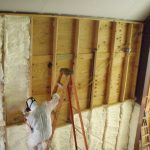Having an adequately insulated home is essential for anything from comfort to reducing energy bills. Deciding what areas of your home are the most important to insulate can be a challenge, but knowing where to start can make a world of difference in terms of both comfort and money saved. This article will provide information on the most important places you should focus on when considering insulation upgrades in your home.
#1: Attic
The attic is the most important area of your home to insulate, as it will have a direct impact on both the temperature and energy efficiency of your home. By properly insulating the attic, you can make sure that heated air stays inside during cold days and cool air remains in your house during hot summer months. Furthermore, by reducing heat loss through the roof and ceiling, you can reduce energy bills substantially due to increased efficiency.
#2: Basement/Crawlspaces
In many homes with basements or crawlspaces, these areas often go neglected when it comes to insulation. This can lead to significant heat loss from below-grade areas of your home. To remedy this issue, consider adding insulation between floors in order for heated air to stay inside your home.
#3: Exterior Walls
When it comes to exterior walls, many people do not realize that these areas are just as important as the attic for insulation purposes. By adding insulation in these areas, you can significantly reduce the amount of heat that is lost due to poor insulation. Furthermore, this will also help keep your home comfortable during extreme temperatures, both hot and cold.
#4: Doors/Windows
Doors and windows are key areas to consider when insulating your home. Adding home insulation around door frames and window sills can help keep warm air inside during cold months while keeping cool air in during hot summer days. Additionally, utilizing insulated curtains can help keep your home comfortable year-round.
#5: HVAC System
It is important to make sure your HVAC system is properly insulated. This can help to ensure that heated or cooled air does not escape through the walls, ceiling, and floors of your home. Additionally, this can help reduce energy bills by reducing the amount of time your HVAC system has to run in order to reach desired temperatures.
#6: Pipes And Ducts
Another important matter to consider is making sure that any pipes or ducts in your home are properly insulated. This will help to ensure that heated air or cool air does not escape through these areas.
#7: Electrical Outlets
Finally, it is important to consider insulating electrical outlets in your home. This can help reduce drafts and air leaks that may occur around these areas, allowing for more efficient use of energy throughout the home.
The primary benefit of insulating your home is improved energy efficiency and cost savings. By properly insulating the attic, basement/crawlspaces, exterior walls, doors/windows, HVAC system, pipes and ducts, and electrical outlets, you can save money on utility bills each month due to reduced energy usage. Additionally, home insulation can also keep your home comfortable during extreme temperatures by helping retain heated air in winter months or cool air in summer months.
In conclusion, it is important to consider all areas of your home when planning a home insulation upgrade project. Focusing on key areas that are often neglected, such as attics, basements/crawlspaces, exterior walls, and windows/doors, can provide a substantial return on investment. According to iFoam, with proper insulation, you will see steadier temperatures and lots of savings.







